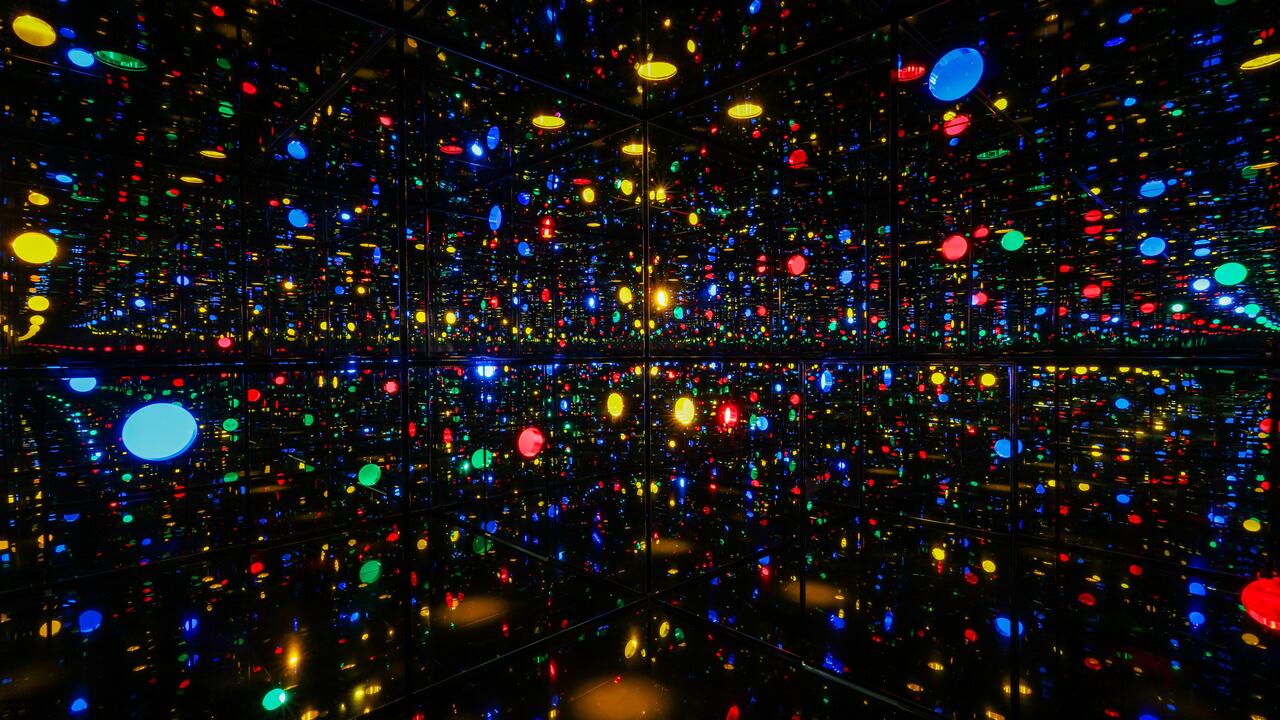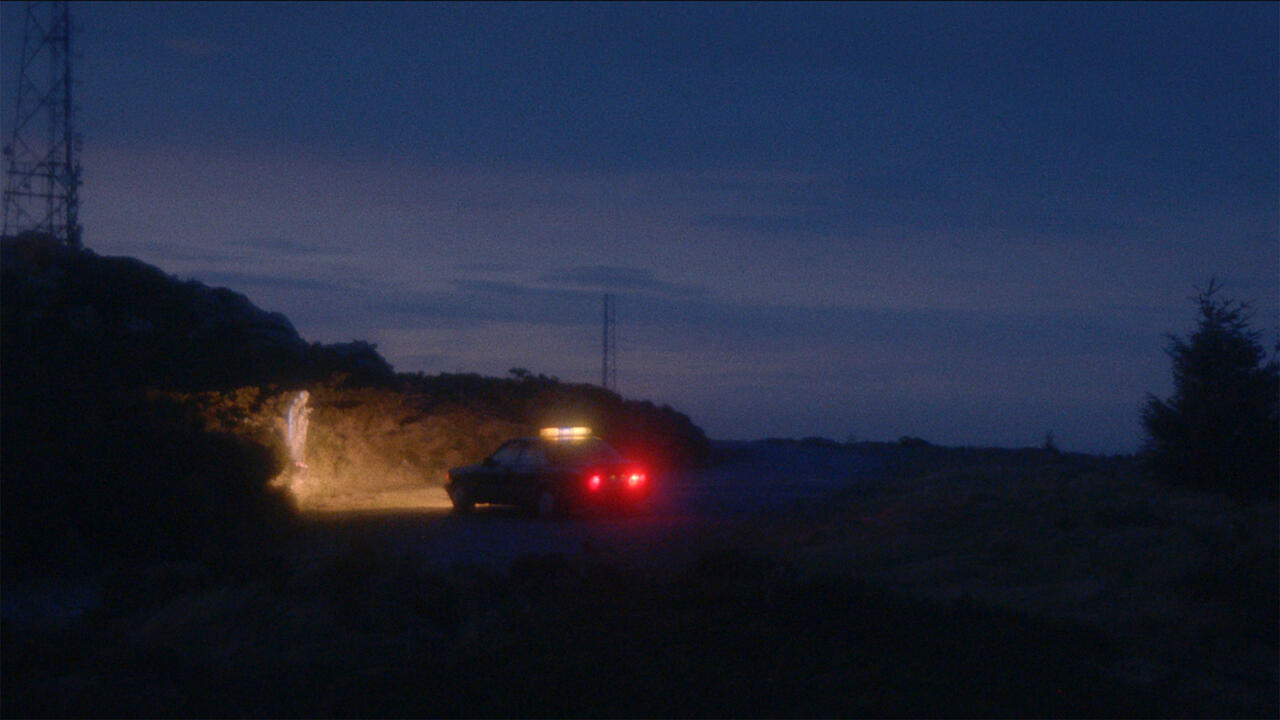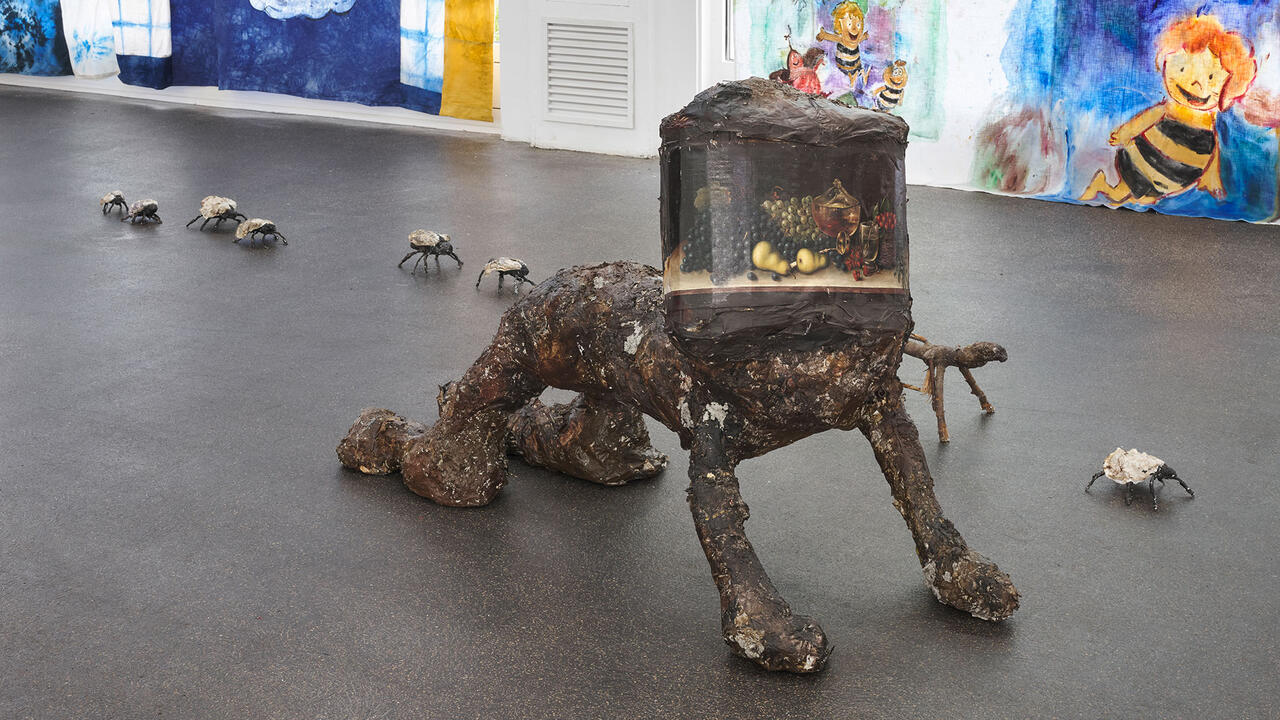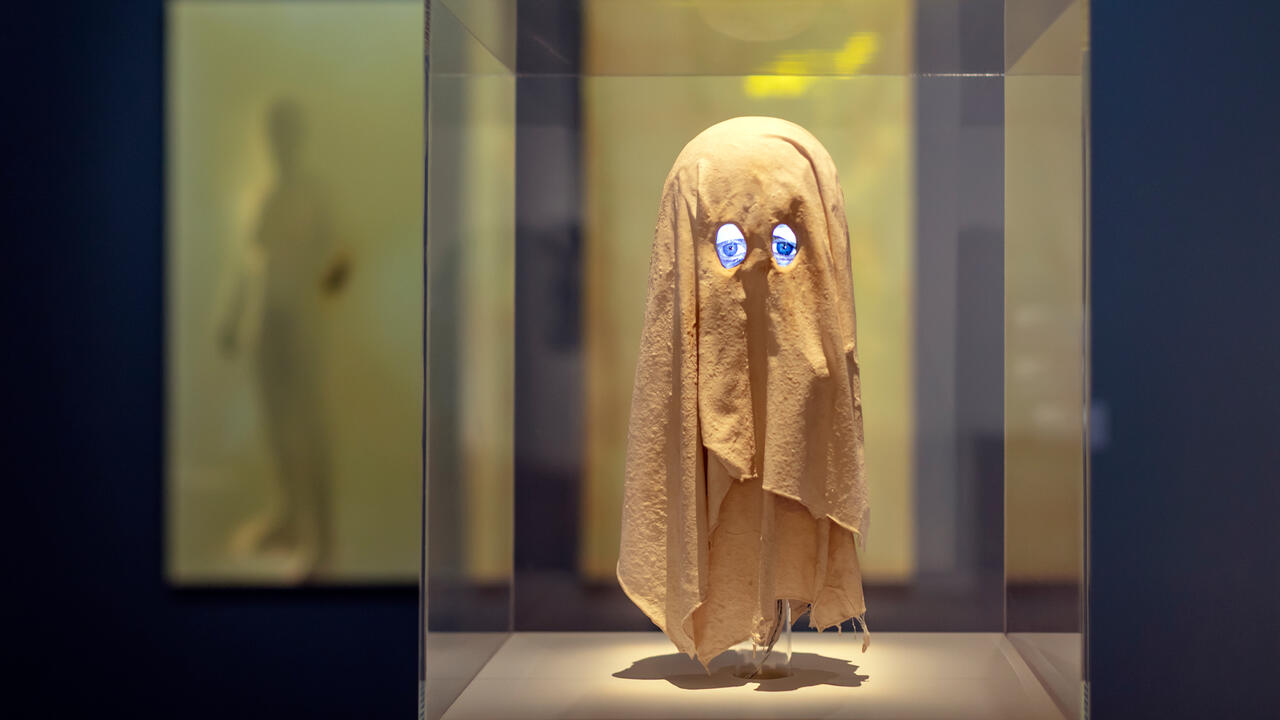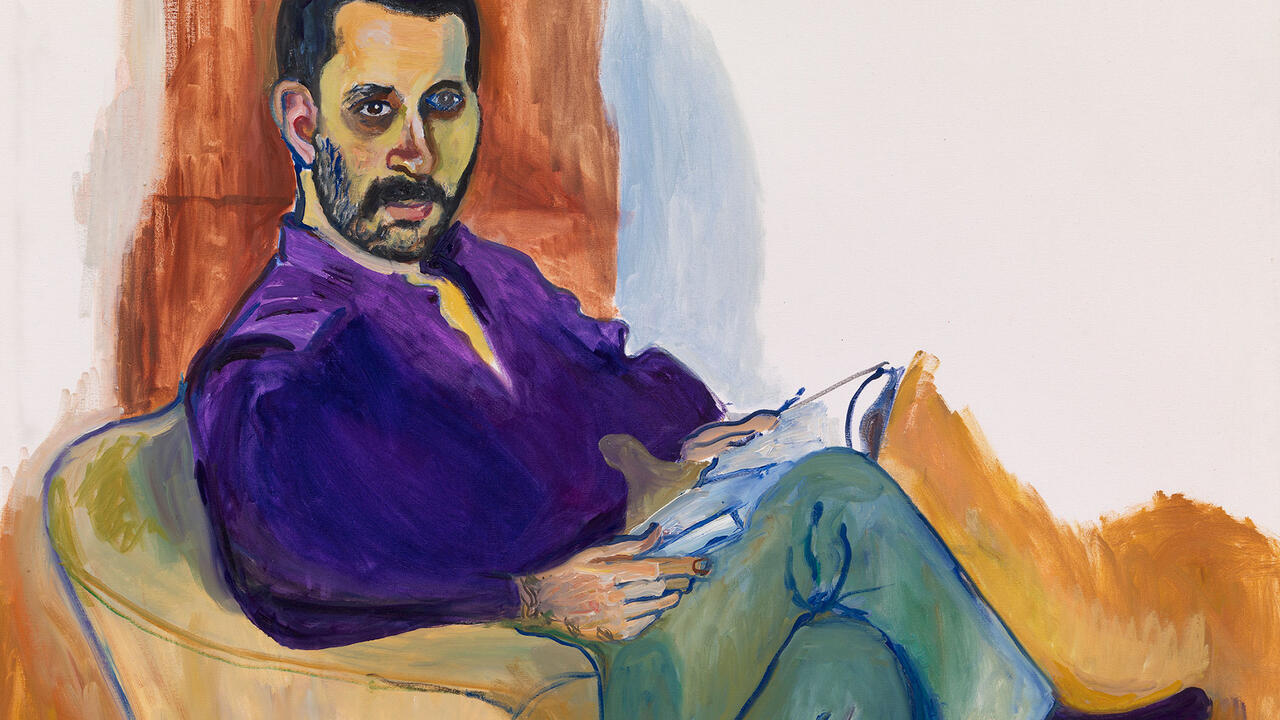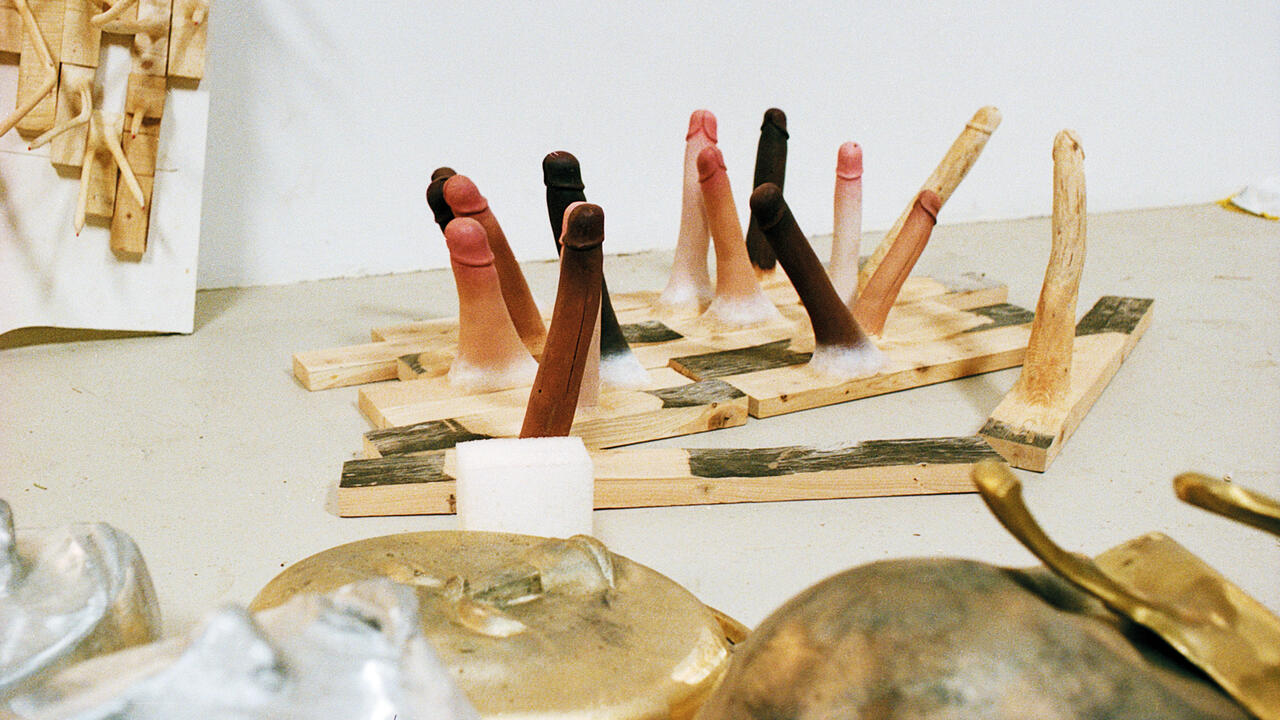Singapore, Shanghai and Gwangju Biennials
Three biennials in Singapore, China and Korea, themed around ‘Belief’, ‘Hyper-Design’ and ‘Fever Variations’
Three biennials in Singapore, China and Korea, themed around ‘Belief’, ‘Hyper-Design’ and ‘Fever Variations’

Singapore looks like a model city: eclectic cutting-edge architecture, impressive civic buildings, a curious lack of poverty or of derelict areas, sparkling gum-free pavements, tropical temperatures, a diversity of races and religions (living together in housing blocks according to enforced government quotas) and, in the middle of it all, a large grassy field reserved for patriotic activities – the site of the opening ceremony of the first Singapore Biennial. On a giant stage beside a grand tent an MC made flat jokes in a slick voice while introducing a parade of disastrous performances, arguably the worst of which was the unveiling of two new Singaporean mascots designed by Swiss artists Com&Com, dressed in oversized fuzzy animal suits. At around 8pm the MC began counting down to the arrival of Prime Minister Lee Hsien Loong, but when he eventually arrived with his entourage, he was greeted on stage with only the meekest smattering of applause. And there it was: the ambition and indifference of the biennial itself summed up in one moment – a well-organized event bursting with civic pride, paraded by plenty of fanfare yet culminating in a lacklustre result and a slightly confused, conciliatory response.
With apparently no shortage of budget or government support, the Biennial was pegged as the ‘anchor cultural event’ in a series of international conferences taking place in Singapore in 2006, most notably the meeting of the International Monetary Fund. When our driver proudly announced this as we rode the immaculate, orchid-lined highway into town, it started to become clear that the Biennial was undertaken as a small part of a larger plan to position Singapore on the international stage (In fact, representatives couldn’t confirm that there would be a second Singapore Biennial).
Under the theme of ‘Belief’ the four-person curatorial team, led by Fumio Nanjo, ambitiously installed works in civic and religious venues throughout the city, including the Maghain Aboth Synagogue, Singapore Management University and the offices of City Hall. To its credit this strategy allowed foreign visitors a chance to explore the city (if only to find that some of the religious sites are, in fact, located a few steps away from one another on the same street). Unfortunately, many of the artworks installed in the religious buildings were relegated to administrative or backstage areas. I was thrilled to be allowed inside the Masjid Sultan Mosque, but embarrassed to be interrupting the worshippers as I wandered around looking for the lift to take me to the rooftop, where I found myself alone with the sound of generators and air-conditioning fans. Here Imran Qureshi had painted flower petals and water drops coming from the exterior water pipes, in a statement that simply and subtly blended in with the surroundings. Qureshi’s Wuzu 2 (2006) was more successful than most of the other religious-sited works, which often appeared intrusive when inserted in the context of thousand-year-old traditions.
While these site-specific works were given space in dedicated venues, the Tanglin Camp – a disused army training camp a few miles away from the city centre – was a receptacle for many of the almost 100 ‘multi-media’ works in the Biennial. A few of these works signalled a discouraging trend: the artistic documentation of people in underprivileged countries learning to perform songs from the West. In adjacent run-down rooms Johanna Billing’s Magical World (2005) and Bani Abidi’s Shan Pipe Band Learns Star-Spangled Banner (2004) amplified each other’s similarly flawed premises. In the former, Croatian children learning an English song provide both the content and the soundtrack of the work, leaving the artist with curiously little work to do, as though I should feel obliged to wilt at the sound of their wavering voices. The latter was a two-screen video of four men crouched on a carpet in a small hovel in Pakistan rehearsing the American anthem in a cacophony of bagpipes and clarinets. Apparently the old trope of translating Western culture to less developed countries hasn’t progressed much since the 1980 film The Gods Must be Crazy, when a Coke bottle drops from the sky into the middle of Africa and we’re all asked to be entertained by the results.
The Biennial’s most fruitful venue was the City Hall, in which decommissioned court rooms with wood-panelled walls and heavy red curtains became the backdrops for works. The few pieces that attempted to work within this loaded context were the most successful, particularly Tzu Nyen Ho’s The Bohemian Rhapsody Project (2006), a music video featuring a series of actors auditioning for the role of a prisoner on trial, filmed in the same courtrooms I had just walked through. Ho portrays angry jurors, hallucinatory guitar solos and a judge in a white wig handing down his verdict while presiding over the camera crew who films him, in a work that borrows Aernout Mik’s uncanny style and Francesco Vezzoli’s Pop appeal.
More importantly, the theme of ‘Belief’ began to take shape in this venue, touching on other aspects of the concept besides religious faith – including justice, monetary values and, most significantly, our belief in artists and artworks themselves. In this last case, the works were far more effective in questioning the role of art and artists than the endless self-referential symposia that accompanied the Biennial. Jonathan Allen’s series of photographic self-portraits posing as the magician/charlatan ‘Tommy Angel’ was not only one of the few works in which the artist was actually present; it was also the first hint that art can also serve to cast doubt on our beliefs. Similarly, Gustavo Romano’s attempts to sell his Time Notes (2006) to people on the street acted as a metaphor for the art market; the artist makes a product and tries to hawk it to the public – some put their faith in it, others think it’s a scam. These works served as a reminder that art’s value and efficacy – like that of religion or justice – depends solely on our belief.
I left the Singapore Biennial with the impression that, like the city itself, it was a well-intentioned assembly of diverse cultures and beliefs, yet ultimately one that seemed artificial and lacking in spirit. Despite this, I began truly to appreciate the effort put in by its organizers by the time I got to Shanghai, where there was no available schedule of press events, and the budget had been cut until all the works were crammed into the Shanghai Art Museum, a former racetrack clubhouse.
In contrast to the flexible and abstract concept of ‘Belief’, the theme of the 6th Shanghai Biennial, ‘Hyper Design’, reduced the works on display to their formal qualities and limited their emotional content or artistic subjectivity. The term ‘Design’ would suggest the works might have some kind of practical or potential application, but judging from the overblown pieces on display, many of the artists were actually borrowing their aesthetics and their production techniques from elements that were already visible on Shanghai’s skyline or within its rapidly expanding consumer culture. Chen Wenbo’s series of fractured paintings of broken CDs (‘Pirated-Copyrighted’, 2006), for instance, resembled the kinds of objects found in Shanghai’s gaudiest hotel lobbies. As a result, the theme was interesting only when artists seemed to reject it, suggesting ‘Hypo Design’ instead: Joe Scanlan’s coffins constructed from Ikea bookshelves, Circular Economy (2006) (which also resembled compact sleeping units), for example. In contrast to the slick, finish fetish objects or demonstrative installations, the most impractical efforts – such as that of Massimo Bartolini, who painstakingly elevated and reconstructed the floor of one of the storage rooms (40cm higher, 2006) – were the most satisfying.
The Shanghai Biennial brought to light another problem inherent to the biennial format: was the exhibition for the locals or for an international audience? While Singapore’s Biennial included only 12 artists from Singapore out of nearly 200 participants, the Shanghai Biennial appeared to be working under a strict remit to give Chinese artists pride of place. Unfortunately the Chinese art in this show, with few exceptions, stood out for its literalness and lack of subtlety. Overproduced and overwrought works such as Wecheng Tu’s museological display of fictional artefacts, (Finds from Bu Nam Civilization in Shanghai, 2006), took up three rooms with its demonstrative light-box displays, threatening to upstage subtler efforts, such as Paul Ramírez Jonas’ The Missing Note (2006), a string of bells programmed to play China’s former national anthem, with one note missing (the note corresponding to the word ‘happy’). In the same way, the attempt to create an air of officiousness surrounding the Biennial – with marching police squads, tight security and a planned giant-screen projection of the opening night speeches – backfired when works were censored, the opening banquet was abruptly cancelled because of rain, and the security detail refused to let some of the artists into the opening.
While the biennials in Shanghai and Singapore strove to attract and impress international audiences, the Gwangju Biennial felt more like a manifestation of civic pride. In my Lonely Planet Guide to Korea the Gwangju Biennial was one of the only events mentioned on the two pages dedicated to Gwangju, suggesting both the unremarkableness of Korea’s fifth-largest city and the importance of the Biennial to its local and national audiences. Although the unfortunately titled ‘Fever Variations’ suffered from too many curators, too much rhetoric and a tangle of convoluted subdivisions, it also had the most instances of what I look for in a biennial: a sense of connection among the works.
Despite its many confusing and superfluous subdivisions or ‘Chapters’, the Biennial was essentially split into two sections (located in adjoining buildings), each with a distinct curatorial strategy. The first was more formal and minimally installed, displaying works that had a close connection with history and tradition. In the second the tone shifted towards more tentative or inconclusive descriptions of geographical locations and subcultures, while the subjects of the works shifted towards topographies of Asian cities, migrations of populations and borders. The strongest and most convincing of the three sections was curated by Cristina Ricupero, who assembled works that functioned to create a fractious, uncertain portrait of the world. Many of the artists in Ricupero’s ‘Last Chapter’ served as ciphers for marginalized or hidden fragments of society: prostitutes in Amsterdam, gay subcultures or Nepalese immigrants in Korea. Others, such as Deimantas Narkevicius’ fictional document of Lithuanian actresses providing testimonies of the victimized characters they play on television (Matrioskos, 2005), called this methodology into question. Gimhongsok’s installation, Salon de belle-soeur (2006), a white room covered in black graffiti written in broken English, mimicked the way meanings can become mangled across international borders and confronted some of the West’s disturbing artistic trends, including the use of children being asked to sing or recite Western words. In one video, Journey to the World Songs (2006), a Korean boy struggles to deliver a speech by JFK but garbles the words so badly that it’s more painful than touching to watch. Works such as this cast a doubting eye on the efficacy of cultural exchange through biennials, an idea that was perhaps summed up best in Jens Haaning and Superflex’s Korean Flamingo project (2006), in which they exported a Korean flamingo to a zoo in Denmark.
If many of the works in this section showed how artists can offer subjective proposals about particular places through topographical strategies, the ‘Latin America’ section, organized by the artist group Apporea, revealed what happens when this subjective filter is removed. In a museological display entitled ‘Exhibiting US Imperialism and War’ they presented press photos and timelines to demonstrate their thesis, suggesting that artists trying to present a biased view as unbiased are simply indulging in propaganda.
By the time fatigue set in and I found myself torn between watching the videos properly and making it to the next conference, it was hard not to ponder the obvious: is bigger better? Despite the collective chuckle the art world seems to share about the proliferation of biennials, it doesn’t stop. There aren’t just more biennials, but more curators for each biennial, more countries represented, more themes, more artists, more discussion about the future of biennials, more venues and more school groups and collectors’ tours shuttled through their doors. And yet it seems obvious that more doesn’t mean better – more media rolled into one artwork, more video screens overshadowing everything in their wake. When quantities of works are accumulated and piled together in the hope that in their midst at least a few meaningful threads will emerge, I find myself longing for a smaller, more concise, more coherent exhibition, with a single, curatorial, even authorial voice.
Christy Lange is assistant editor of frieze.





